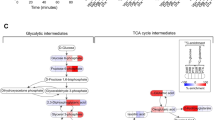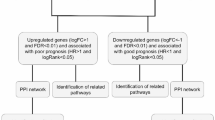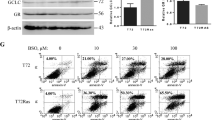Abstract
The use of oncolytic peptides with activity against a wide range of cancer entities as a new and promising cancer therapeutic strategy has drawn increasing attention. The oncolytic peptide LTX-315 derived from bovine lactoferricin (LfcinB) was found to be highly effective against suspension cancer cells, but not adherent cancer cells. In this study, we tactically fused LTX-315 with rhodamine B through a hybridization strategy to design and synthesize a series of nucleus-targeting hybrid peptides and evaluated their activity against adherent cancer cells. Thus, four hybrid peptides, NTP-212, NTP-217, NTP-223 and NTP-385, were synthesized. These hybrid peptides enhanced the anticancer activity of LTX-315 in a panel of adherent cancer cell lines by 2.4- to 37.5-fold. In model mice bearing B16-F10 melanoma xenografts, injection of NTP-385 (0.5 mg per mouse for 3 consecutive days) induced almost complete regression of melanoma, prolonged the median survival time and increased the overall survival. Notably, the administered dose of NTP-385 was only half the effective dose of LTX-315. We further revealed that unlike LTX-315, which targets the mitochondria, NTP-385 disrupted the nuclear membrane and accumulated in the nucleus, resulting in the transfer of a substantial amount of reactive oxygen species (ROS) from the cytoplasm to the nucleus through the fragmented nuclear membrane. This ultimately led to DNA double-strand break (DSB)-mediated intrinsic apoptosis. In conclusion, this study demonstrates that hybrid peptides obtained from the fusion of LTX-315 and rhodamine B enhance anti-adherent cancer cell activity by targeting the nucleus and triggering DNA DSB-mediated intrinsic apoptosis. This study also provides an advantageous reference for nucleus-targeting peptide modification.
Similar content being viewed by others
Log in or create a free account to read this content
Gain free access to this article, as well as selected content from this journal and more on nature.com
or
References
Sung H, Ferlay J, Siegel RL, Laversanne M, Soerjomataram I, Jemal A, et al. Global Cancer Statistics 2020: GLOBOCAN Estimates of Incidence and Mortality Worldwide for 36 Cancers in 185 Countries. CA Cancer J Clin. 2021;71:209–49.
Zhitomirsky B, Assaraf YG. Lysosomes as mediators of drug resistance in cancer. Drug Resist Updat. 2016;24:23–33.
Wang N, Xie G, Liu C, Cong W, He S, Li Y, et al. Design, synthesis, and antitumor activities study of stapled A4K14-citropin 1.1 peptides. Front Chem. 2020;8:616147.
Mader JS, Richardson A, Salsman J, Top D, de Antueno R, Duncan R, et al. Bovine lactoferricin causes apoptosis in Jurkat T-leukemia cells by sequential permeabilization of the cell membrane and targeting of mitochondria. Exp Cell Res. 2007;313:2634–50.
Sveinbjornsson B, Camilio KA, Haug BE, Rekdal Ø. LTX-315: a first-in-class oncolytic peptide that reprograms the tumor microenvironment. Future Med Chem. 2017;9:1339–44.
Forveille S, Zhou H, Sauvat A, Bezu L, Muller K, Liu P, et al. The oncolytic peptide LTX-315 triggers necrotic cell death. Cell Cycle. 2015;14:3506–12.
Spicer J, Marabelle A, Baurain JF, Jebsen NL, Jossang DE, Awada A, et al. Safety, antitumor activity, and T-cell responses in a dose-ranging phase I trial of the oncolytic peptide LTX-315 in patients with solid tumors. Clin Cancer Res. 2021;27:2755–63.
Haug BE, Camilio KA, Eliassen LT, Stensen W, Svendsen JS, Berg K, et al. Discovery of a 9-mer cationic peptide (LTX-315) as a potential first in class oncolytic peptide. J Med Chem. 2016;59:2918–27.
Tornesello AL, Borrelli A, Buonaguro L, Buonaguro FM, Tornesello ML. Antimicrobial peptides as anticancer agents: functional properties and biological activities. Molecules. 2020;25:2850.
Nestvold J, Wang MY, Camilio KA, Zinocker S, Tjelle TE, Lindberg A, et al. Oncolytic peptide LTX-315 induces an immune-mediated abscopal effect in a rat sarcoma model. Oncoimmunology. 2017;6:e1338236.
Zhou X, Zuo C, Li W, Shi W, Zhou X, Wang H, et al. A novel D-peptide identified by mirror-image phage display blocks TIGIT/PVR for cancer immunotherapy. Angew Chem Int Ed. 2020;59:15114–8.
Chang HN, Liu BY, Qi YK, Zhou Y, Chen YP, Pan KM, et al. Blocking of the PD-1/PD-L1 interaction by a D-peptide antagonist for cancer immunotherapy. Angew Chem Int Ed. 2015;54:11760–4.
Eksteen JJ, Ausbacher D, Simon-Santamaria J, Stiberg T, Cavalcanti-Jacobsen C, Wushur I, et al. Iterative design and in vivo evaluation of an oncolytic antilymphoma peptide. J Med Chem. 2017;60:146–56.
Zhou H, Forveille S, Sauvat A, Yamazaki T, Senovilla L, Ma Y, et al. The oncolytic peptide LTX-315 triggers immunogenic cell death. Cell Death Dis. 2016;7:e2134.
Vitale I, Yamazaki T, Wennerberg E, Sveinbjørnsson B, Rekdal Ø, Demaria S, et al. Targeting cancer heterogeneity with immune responses driven by oncolytic peptides. Trends Cancer. 2021;7:557–72.
Luan X, Wu Y, Shen YW, Zhang H, Zhou YD, Chen HZ, et al. Cytotoxic and antitumor peptides as novel chemotherapeutics. Nat Prod Rep. 2021;38:7–17.
Wu Y, Lu D, Jiang Y, Jin J, Liu S, Chen L, et al. Stapled Wasp venom-derived oncolytic peptides with side chains induce rapid membrane lysis and prolonged immune responses in melanoma. J Med Chem. 2021;64:5802–15.
Liao HW, Garris C, Pfirschke C, Rickelt S, Arlauckas S, Siwicki M, et al. LTX-315 sequentially promotes lymphocyte-independent and lymphocyte-dependent antitumor effects. Cell Stress. 2019;3:348–60.
Meunier B. Hybrid molecules with a dual mode of action: Dream or reality? Acc Chem Res. 2008;41:69–77.
Mehta G, Singh V. Hybrid systems through natural product leads: an approach towards new molecular entities. Chem Soc Rev. 2002;31:324–34.
Tsogoeva SB. Recent progress in the development of synthetic hybrids of natural or unnatural bioactive compounds for medicinal chemistry. Mini-Rev Med Chem. 2010;10:773–93.
Mottram LF, Forbes S, Ackley BD, Peterson BR. Hydrophobic analogues of rhodamine B and rhodamine 101: potent fluorescent probes of mitochondria in living C. elegans. Beilstein J Org Chem. 2012;8:2156–65.
Eike LM, Yang N, Rekdal Ø, Sveinbjørnsson B. The oncolytic peptide LTX-315 induces cell death and DAMP release by mitochondria distortion in human melanoma cells. Oncotarget. 2015;6:34910–23.
Kawanishi S, Hiraku Y, Pinlaor S, Ma N. Oxidative and nitrative DNA damage in animals and patients with inflammatory diseases in relation to inflammation-related carcinogenesis. Biol Chem. 2006;387:365–72.
Chen XT, Wang JY, Ma YN, Dong LY, Jia SX, Yin H, et al. DIC/Oxyma-based accelerated synthesis and oxidative folding studies of centipede toxin RhTx. J Pep Sci. 2022;28:e3368.
Yin H, Chen X, Fu X, Ma Y, Xu Y, Zhang T, et al. Efficient chemical synthesis and oxidative folding studies of scorpion toxin peptide WaTx. Acta Chim Sin. 2022;80:444–52.
Ma Y, Liu Y, Wang J, Chen X, Yin H, Chi Q, et al. DIC/Oxyma based efficient synthesis and activity evaluation of spider peptide toxin GsMTx4. Chin J Org Chem. 2022;42:498–506.
Liu Z, Zhang S, Hou F, Zhang C, Gao J, Wang KW. Inhibition of Ca2+-activated chloride channel ANO1 suppresses ovarian cancer through inactivating PI3K/Akt signaling. Int J Cancer. 2019;144:2215–26.
Yao X, Zhao CR, Yin H, Wang KW, Gao JJ. Synergistic antitumor activity of sorafenib and artesunate in hepatocellular carcinoma cells. Acta Pharmacol Sin. 2020;41:1609–20.
Birtalan E, Rudat B, Kolmel DK, Fritz D, Vollrath SBL, Schepers U, et al. Investigating rhodamine B-labeled peptoids: scopes and limitations of its applications. Biopolymers. 2011;96:694–701.
Roos WP, Kaina B. DNA damage-induced cell death by apoptosis. Trends Mol Med. 2006;12:440–50.
Liu T, Yao R, Pang Y, Sun W. Review on biofabrication and applications of heterogeneous tumor models. J Tissue Eng Regen Med. 2019;13:2101–20.
Teicher BA. Tumor models for efficacy determination. Mol Cancer Ther. 2006;5:2435–43.
Trachootham D, Alexandre J, Huang P. Targeting cancer cells by ROS-mediated mechanisms: a radical therapeutic approach? Nat Rev Drug Discov. 2009;8:579–91.
Bonner WM, Redon CE, Dickey JS, Nakamura AJ, Sedelnikova OA, Solier S, et al. γH2AX and cancer. Nat Rev Cancer. 2008;8:957–67.
Acknowledgements
This project was supported by grants from the National Natural Science Foundation of China (81973299, 22177058, 82003647), the China Postdoctoral Science Foundation (2020T130332, 2019M652307), and the Qingdao postdoctoral application research project.
Author information
Authors and Affiliations
Contributions
HY designed research; HY performed research; YKQ designed oncolytic peptides; XTC, YNM and XYF synthesized peptides; HY and QNC performed MTT assay; HY and YKQ analyzed data; HY wrote the paper; SSD, YKQ and KWW prepared the paper.
Corresponding authors
Ethics declarations
Competing interests
The authors declare no competing interests.
Supplementary information
Rights and permissions
About this article
Cite this article
Yin, H., Chen, Xt., Chi, Qn. et al. The hybrid oncolytic peptide NTP-385 potently inhibits adherent cancer cells by targeting the nucleus. Acta Pharmacol Sin 44, 201–210 (2023). https://doi.org/10.1038/s41401-022-00939-x
Received:
Accepted:
Published:
Issue date:
DOI: https://doi.org/10.1038/s41401-022-00939-x
Keywords
This article is cited by
-
Computational and experimental discovery of peptide inhibitors targeting survivin for therapeutic potential in cancer
Scientific Reports (2025)
-
Discovery of a novel potent tubulin inhibitor through virtual screening and target validation for cancer chemotherapy
Cell Death Discovery (2025)
-
Application and mechanism of anticancer peptides in organoid models of intrahepatic cholangiocarcinoma
Scientific Reports (2025)
-
Synthesis and antitumor evaluation of amino acid conjugates of monocarbonyl curcumin in hepatocellular carcinoma cell
Scientific Reports (2025)
-
Probing into 9’-substituted Suzuki-coupled noscapine ionic liquids as potent microtubule targeting anticancer agents with hemoglobin affinity
Scientific Reports (2025)



